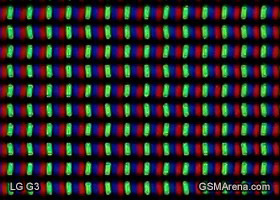LG G3 vs Oppo Find 7: Resolution wars
Resolution wars
Displays
Here's where we'll be answering the question that's on everyone's mind: which of these QHD displays is the better one? As both match each other in resolved detail, we'll be discussing more in-depth the other aspects that factor in to a capable display: contrast, colors, viewing angles, and sunlight legibility.
There are reports of Find 7 displays with spotty color calibration issues, but we could not detect any such issues with our particular model.
Like we mentioned, both phones offer 5.5-inch displays of 1440 x 2560px resolution, which results in a pixel density of around 534 ppi. LG's screen is of the True HD-IPS+ variety, while the Find 7 panel is marketed as simply IPS. While the LG display certainly sounds better, we won't be going on titles alone and will instead let the numbers speak for themselves.
Here's how each of them look under our digital microscope at 800x magnification:


The screen contrast on the Find 7 is very good. It has slightly higher black luminance at 50% brightness, but the contrast ratio is far superior to the numbers provided by the LG G3. The Find 7 is not too far behind the majority of 1080p flagships like the HTC One (M8) and Sony Xperia Z2, while the LG G3 is the poorest we've seen in this generation of flagships.
| Display test | 50% brightness | 100% brightness | ||||
| Black, cd/m2 | White, cd/m2 | Black, cd/m2 | White, cd/m2 | |||
| Oppo Find 7 | 0.22 | 248 | 1135 | 0.40 | 448 | 1123 |
| LG G3 | 0.14 | 109 | 763 | 0.72 | 570 | 789 |
| Sony Xperia Z2 | - | - | - | 0.41 | 488 | 1195 |
| Sony Xperia Z1 | - | - | - | 0.38 | 580 | 1513 |
| Oppo Find 7a | 0.33 | 280 | 842 | 0.68 | 580 | 852 |
| Samsung Galaxy S5 | 0 | 274 | ∞ | 0 | 529 | ∞ |
| Samsung Galaxy S4 | 0 | 201 | ∞ | 0 | 404 | ∞ |
| HTC One (M8) | 0.20 | 245 | 1219 | 0.46 | 577 | 1256 |
| LG G2 | 0.10 | 149 | 1522 | 0.45 | 667 | 1495 |
| HTC Butterfly S | 0.15 | 165 | 1117 | 0.43 | 451 | 1044 |
| Apple iPhone 5 | 0.13 | 200 | 1490 | 0.48 | 640 | 1320 |
Things are more even when it comes to sunlight legibility, but unfortunately not on a good way. The Oppo Find 7 and LG G3 are among the more reflective screens we've tested recently, scoring significantly behind the other recent flagships. The Find 7 sports a factory-installed screen protector, that when removed should result in better figures.
Winner: Oppo Find 7. Screen fidelity being the same, it really comes down to which of the two displays proves superior in contrast, sunlight legibility, viewing angles and colors. In all of these areas (save for sunlight legibility), the Find 7 clearly trumps the LG G3.
Connectivity
Both phones are powered by Qualcomm chipsets and enjoy all the connectivity benefits that come included. The European variant of the LG G3 beats out the Find 7 in the number of supported LTE bands, though both should have you well covered for whatever region you buy the device in.
Wireless connectivity on the LG G3 is covered by dual-band Wi-Fi 802.11ac, which also supports a/b/g/n as well. Meanwhile, the Find 7 relies simply on b/g/n connectivity. Bluetooth 4.0 is available for connecting accessories, although the G3 has the advantage of supporting LE (low energy) peripherals.
Both phones support USB On-the-go capabilities for their USB 2.0 ports, but that's where the similarities end. The LG G3 has and IR-port for controlling televisions, air conditioners, and more, as well as an FM radio antenna (on the European model only).
Winner: LG G3. Although offering largely the same connectivity suite, the G3's IR-port, FM radio, and WiFi ac-support are enough to give it the edge over the Find 7.
Reader comments
- Feride LG G3
- 24 Apr 2016
- SHp
LG G3 forever and ever! I love it.
- Gborgbor
- 04 Oct 2014
- fsT
To me an impressive multi-function with low battery life is just a doll phone
- Anonymous
- 08 Aug 2014
- 5Er
What is the point of having a 2K resolution on a 5.5 inch display which is a ppi of 534? For a display of that size a ppi of 400 is more than enough. You will need higher resolution as the display scales up. For normal eyesight, there is no differenc...

